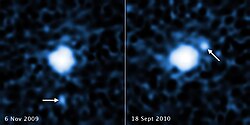225088 Gonggong

225088 Gonggong is a dwarf planet of the Solar System. It is a member of the scattered disc. It has a highly eccentric orbit. It is from 34–101 astronomical units (5.1–15.1 billion kilometers; 3.2–9.4 billion miles) from the Sun. It is the sixth-farthest known Solar System object. Gonggong was discovered in July 2007 by American astronomers Megan Schwamb, Michael Brown, and David Rabinowitz at the Palomar Observatory, and the discovery was announced in January 2009.
Its planetary symbol is ![]() .
.
Physical characteristics
The surface of Gonggong has an albedo of 0.14.[1] Gonggong is among the reddest trans-Neptunian objects known.[2] Its red color is suprising because it has a lot of water ice on its surface, which are usually neutral in color. Scientists think that there might be methane on its surface which will explain its red color.[3]
Gonggong is estimated to have a diameter of 1,230 km (760 mi). This would make Gonggong the fifth-largest trans-Neptunian object, after Pluto, Eris, Haumea and Makemake. Gonggong is approximately the size of Pluto's moon Charon.[1]
The mass of Gonggong has been calculated to be 1.75×1021 kg (3.86×1021 lb). It has a density of 1.72±0.16 g/cm3.
Orbit
Gonggong orbits the Sun at an average distance of 67.5 AU (1.010×1010 km; 6.27×109 mi). It completes a full orbit in 554 years.[4] It has an orbital inclination 30.7 degrees. Its eccentricity is 0.50.[4]
Gonggong is moving away at a speed of 1.1 kilometers per second (2,500 miles per hour). It is the sixth-farthest known Solar System object from the Sun.[5]
Exploration
It was calculated by planetary scientist Amanda Zangari that a flyby mission to Gonggong would take a minimum of over 20 years with the rocket we have today.[6] A flyby mission would be launched on 2030 or 2031.[6]
Moons
Gonggong is known to have a moon, called Xiangliu. The discovery team thought that the slow rotation of Gonggong was caused by a moon.
225088 Gonggong Media
Gonggong was discovered using the Samuel Oschin telescope at Palomar Observatory
A preliminary motion analysis of Gonggong librating in a 3:10 resonance with Neptune. This animation consists of 16 frames covering 26,000 years. Neptune (white dot) is held stationary.
Apparent motion of Gonggong through the constellation Aquarius (years 2000 to 2050)
Hubble images of Gonggong and Xiangliu, taken in 2009 and 2010 with the Wide Field Camera 3
References
- ↑ 1.0 1.1 Kiss, Csaba; Marton, Gábor; Parker, Alex H.; Grundy, Will M.; Farkas-Takács, Anikó; Stansberry, John; Pál, Andras; Müller, Thomas; Noll, Keith S. (2019). "The mass and density of the dwarf planet (225088) 2007 OR10". Icarus. 334: 3–10. arXiv:1903.05439. Bibcode:2019Icar..334....3K. doi:10.1016/j.icarus.2019.03.013. S2CID 119370310.
- ↑ Brown, M. E.; Burgasser, A. J.; Fraser, W. C. (2011-09-10). "The Surface Composition of Large Kuiper Belt Object 2007 Or10". The Astrophysical Journal. 738 (2): L26. arXiv:1108.1418. Bibcode:2011ApJ...738L..26B. doi:10.1088/2041-8205/738/2/L26. hdl:1721.1/95722. ISSN 2041-8205. S2CID 9730804.
- ↑ "Astronomers find ice and possibly methane on Snow White, a distant dwarf planet". ScienceDaily. Retrieved 2020-12-05.
- ↑ 4.0 4.1 "JPL Small-Body Database Browser". ssd.jpl.nasa.gov. Retrieved 2020-12-05.
- ↑ "HORIZONS Web-Interface". ssd.jpl.nasa.gov. Retrieved 2020-12-05.
- ↑ 6.0 6.1 Zangari, Amanda M.; Finley, Tiffany J.; Alan Stern, S.; Tapley, Mark B. (2019). "Return to the Kuiper Belt: Launch Opportunities from 2025 to 2040". Journal of Spacecraft and Rockets. 56 (3): 919–930. arXiv:1810.07811. Bibcode:2019JSpRo..56..919Z. doi:10.2514/1.A34329. ISSN 0022-4650. S2CID 119033012.






